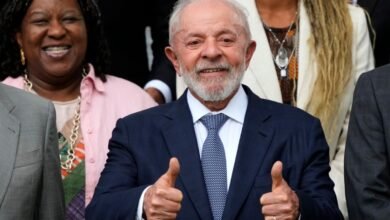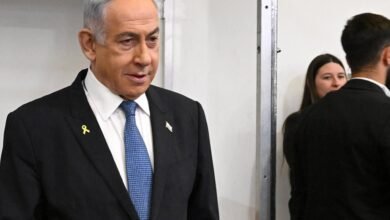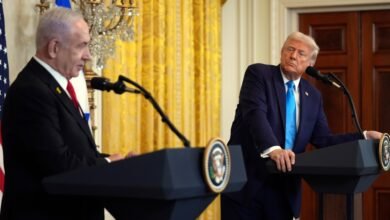Russia stalls ceasefire talks as it intensifies attacks on Ukraine | Russia-Ukraine war News

Russia has added new conditions for a ceasefire to a litany of existing ones, prompting United States President Donald Trump to threaten new sanctions against Russian oil.
Visiting Russia’s newest nuclear submarine, the Arkhangelsk, on March 27, Russian President Vladimir Putin said a temporary administration should be installed in Ukraine to lead the country to elections.
Russian officials have been trying to discredit Ukrainian President Volodymyr Zelenskyy since negotiations began in February, in an apparent effort to undermine Ukraine’s position.
For example, the Kremlin continued to accuse Ukraine of breaking a ceasefire on energy infrastructure, which Moscow proposed on March 18 and Kyiv has not agreed to.
Russian and Ukrainian technical teams have failed to nail down what would be protected under the deal.
On Tuesday, Russian Foreign Minister Sergey Lavrov said he would give his US counterpart a list of energy facilities struck by Ukraine “so that they can present concrete evidence about what the word of the current Ukrainian authorities is worth, if you can call them authorities at all”.
A day later, Kremlin spokesman Dmitry Peskov admitted Ukraine had not actually agreed to the moratorium.

There were many other Russian objections in the ceasefire talks.
Sergey Ryabkov, the Russian deputy foreign minister, told an interviewer on Tuesday that the US-led talks “leave no room for Russia’s core demand” to address “the root causes of this conflict” which officials in Moscow have defined as reversing NATO’s eastward expansion and the treatment of Russian minorities in Ukraine.
Russia also objects to peacekeepers enforcing any ceasefire.
Russian ambassador at large Rodion Miroshnik told an academic conference in Armenia on Wednesday that Russia saw any European force in Ukraine as “a blatant occupation of Ukraine by Europe”.
The European Union has proposed putting a peacekeeping force in place after a peace agreement is signed.
Trump began to show his first signs of impatience with the Russian position on Sunday, telling NBC in a phone call he was “angry and p****d off” with Putin and that he might place a “25 to 50-point tariff on all [Russian] oil” within the next month and sanction companies that buy it.
It was unclear what the relevance of such tariffs would be. Trump’s predecessor, Joe Biden, banned all imports of Russian oil to the US in 2022.

Trump’s impatience came on the day he played golf with Finnish President Alexander Stubb, who told him a deadline was necessary to make a ceasefire happen.
“April 20 would be a good time for a full ceasefire without any conditions … because a deadline is needed, because it is Easter and because President Donald Trump will have been in office for three months,” Stubb later told reporters.
Trump did not adopt Stubb’s suggestion, telling reporters on Monday the deadline was “psychological … If I think they’re tapping us along I will not be happy about it,” he said on board Air Force One.
Asked if he thought Putin was stalling, he said, “I don’t know. I don’t think so. I think he wants to make a deal.”
The Office of the Director of National Intelligence (ODNI) suggested Putin was not likely to reach a quick ceasefire.
ODNI’s 2025 Annual Threat Assessment on Thursday said Putin “appears resolved and prepared to pay a very high price to prevail in what he sees as a defining time in Russia’s strategic competition with the United States, world history, and his personal legacy”.
Russian attacks unabated
Ukraine’s Ministry of Defence said Russia increased its assaults along the front line even as it negotiated a ceasefire.
Combat clashes numbered 4,270 in March compared with 3,274 in February, it said.
Russia was also not relaxing its use of glide bombs – some 10,577 have been used in the first three months of the year. All of last year, 40,000 were used, the ministry said.
Russian forces may have seized the village of Novolyubivka near Lyman on Tuesday.
Their long-range aerial attacks also continued unabated throughout the week.

Russia launched 172 drones against Ukraine on March 29, of which 94 were shot down and 69 disoriented using electronic jamming. Several drones struck high-rise apartment blocks in Dnipro, setting at least a dozen houses alight. Four people were reported killed and 21 injured.
Zelenskyy in his evening address said drones hit houses and a hospital in Kharkiv, injuring 55 people, including five children.
German magazine Bild said Russia was improving its tactics by grouping drones in loitering formations at high altitudes before sending them all to strike a target at once.
Russia sent 111 drones to strike a military hospital and civilian infrastructure in Kharkiv city on Sunday morning. Ukraine downed 65 and disoriented 34. Six Shahed drones also hit civilian properties in the Kharkiv region, causing several injuries.
“The geography and brutality of Russian strikes, not just occasionally, but literally every day and night, show that Putin couldn’t care less about diplomacy,” Zelenskyy said in his evening address on Sunday.
“For several weeks now, there has been a US proposal for an unconditional ceasefire. And almost every day, in response to this proposal, there are Russian drones, bombs, artillery shelling and ballistic strikes. Russia deserves increased pressure.”
But Russian strikes continued, hurting civilians.
On Wednesday a Russian missile injured 17 civilians including a child in Kryvyi Rih, part of an overnight attack of 74 Shahed drones, of which 41 were shot down and 20 disoriented, said the Ukrainian Air Force.
The air force said it shot down more drones the following night.
Only in the Black Sea did Russia seem to show any real will for a ceasefire. Navy spokesman Dmytro Pletenchuk said though there was no official ceasefire, in practice, Russian forces were not attacking Ukrainian ports, and the Black Sea Fleet remained in the eastern part of the Black Sea.
Ukrainian manpower and weapons
Ukraine said it made advances in recruitment and training in the past months.
Commander-in-chief Oleksandr Syrskii said improved training showed results in March.
“We have … increased the duration [of training] to 1.5 months, introduced a mandatory adaptive period for newcomers to combat brigades, and this is yielding positive results,” he wrote on social media on Monday. “This month we recorded a decrease in losses compared to the previous ones.”
Conscription is mandatory for Ukrainian males aged 25 and older. This year, Zelenskyy launched voluntary conscription for those aged 18-24.
Last month Ukraine’s Defence Ministry increased the number of brigades accepting such volunteers from six to 16, expanding recruitment from land forces to naval, airborne and unmanned units.
This week, Defence Minister Rustem Umerov said the 18-24 volunteer law had been amended to allow recruits to the National Guard and State Border Service in addition to the armed forces.
Ukraine’s Defence Ministry said 884 people volunteered to join the armed forces in March, versus 9,765 for the entire war, suggesting volunteer recruitment rates were climbing.

The Harpies, a volunteer unit operating unmanned vehicles, targets women, and last week advertised itself as “an environment for women who seek revenge on the enemy, to protect their children, families and the state”.
“The unit also involves men, but the role of pilots delivering the final blow will be performed exclusively by women,” it said.
Convicts are also playing a role.
Ukrinform, the Ukrainian armed forces information service, said 8,000 former convicts had joined the armed forces and 900 applications were in process. Parole was approved in the May 2024 law that lowered the compulsory conscription age to 25.
Ukraine has been designing its own weapons to boost autonomy, speed up construction, lower costs and allow their unrestricted use.
This week the Defence Ministry reported it approved 350 new weapons for use so far this year, 87 percent of them domestically produced, compared with fewer than half of the 100 or so models approved last year.
Europe’s stance
Europe continued to provide Ukraine with generous weapons support.
Zelenskyy met German Foreign Minister Annalena Baerbock in Kyiv on Tuesday and thanked her for a new 3bn-euro ($3.3bn) military aid package, bringing Germany’s 2025 total to 7bn euros ($7.7bn) and war total to 43bn euros ($47.4bn).
The Netherlands on Monday said it was releasing a 500m-euro ($550m) tranche to help drone operations better integrate with ground operations.
Sweden announced a $1.6bn aid package to improve Ukraine’s air defence, artillery, satellite communications and naval capabilities.
The United Kingdom and France said on Wednesday they would chair a meeting of countries contributing peacekeepers at NATO headquarters on April 10.
The UK and Germany, meanwhile, plan to chair a meeting of the Ukraine Defense Contact Group providing weapons to Ukraine the following day. It will be the second Ramstein meeting not attended by the US, which has adopted a neutral stance.
Asked whether Europe was willing to enter a dialogue with Putin, Kremlin spokesman Peskov said on Thursday, “There have been no signals yet.”
https://www.aljazeera.com/wp-content/uploads/2025/04/2025-04-04T084636Z_1961137491_RC2AQDAVAMI3_RTRMADP_3_UKRAINE-CRISIS-DRILLS-1743762190.jpg?resize=1920%2C1440







